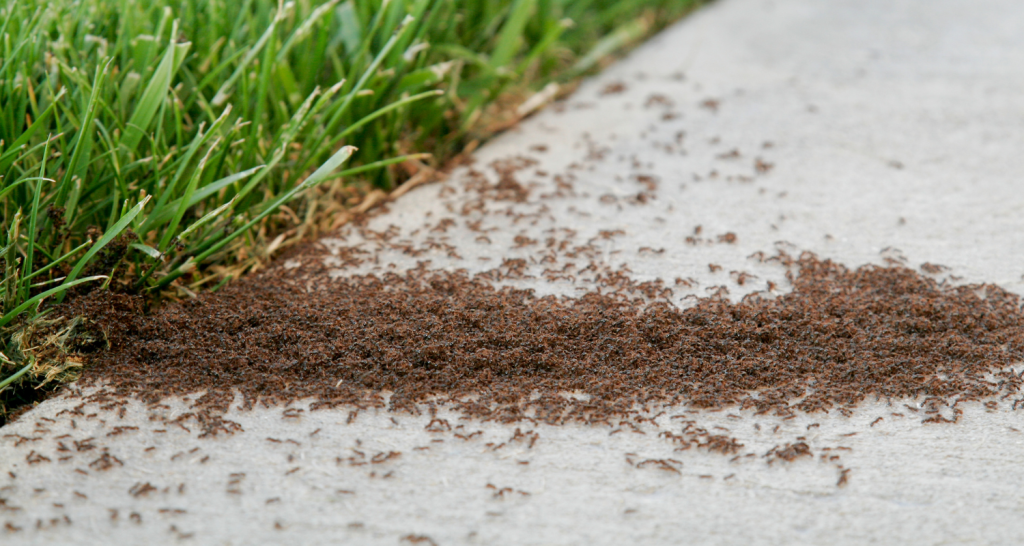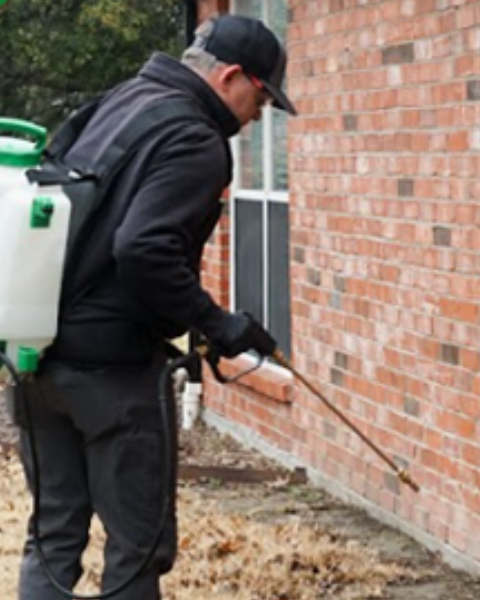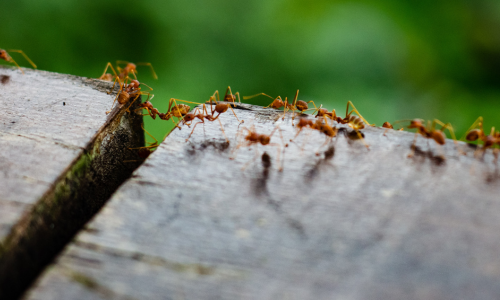
Here Come the Fire Ants!
Sentry Exterminating specializes in fire ant pest control. Fire ants are a mighty little species of ant, native to South America and accidentally imported into the United States more than a hundred years ago. Fire ants might be small, but they pack a powerful punch with their aggressive behavior and venomous, painful fire ant sting.

Experience & Expertise
With over 50 years of invaluable experience in pest control, Sentry Exterminating has honed its expertise to perfection. Our time-tested methods guarantee effective solutions for all your pest problems. Trust in our half-century legacy of excellence.
Fire Ant Identification In NE North Carolina
In North Carolina, our main species of fire ant is the Southern Fire Ant (Solenopsis Xyloni). They are what is called “polymorphic”. That means the worker ants come in varied shapes and sizes instead of all one size fits all.
There are different color patterns as well. Workers are yellowish to red with a brown to black bum (or gaster is the body part that carries that painful fire ant sting). The southern fire ant tends to be a bit darker than the red imported fire ant (Solenopsis invicta) their close cousins further south.
Reproductives, the colony members with wings, will have the same yellowish red but are even a bit darker. The males are completely black.

What Makes Fire Ants Different?
Fire ants live in colonies that can reach hundreds of thousands strong and feed on just about anything from other insects to seeds, and even small critters.
Now what sets these fire ants apart from other ants, is that venomous sting I mentioned.
It’s not for the faint of heart, it can cause some folks to have an allergic reaction, so watch out!
You don’t want to stir the pot with these little devils.
When you disturb their nest even just a little, they come boiling up, mad as heck, and start climbin’ up anything they can find, rarin’ to take a bite and give a painful sting to whoever riled ‘em.

Do Fire Ants Come Inside?
Folks, let me tell you ’bout these fire ants. They can be real trouble for our homes. They sneak in through tiny cracks and holes in the foundation, walls, and floors. And once they’re inside, watch out!
Once inside, fire ants can gnaw on our electrical wiring insulation, including in our appliances, causing all sorts of damage.
And if that wasn’t enough, they also like to build their mounds right next to our houses, which can undermine our foundations and sidewalks.
And to top it all off, they can even contaminate our food and kitchen surfaces, which is not good for our health. So, let’s be on the lookout for these pesky critters.
Fire Ant Control: How Do We Keep Them Out?
Listen, folks, if you want to keep fire ants out of your home, you gotta have fire ant control in your yard. These little pests love to set up shop in outdoor areas like yards, gardens, and parks.
And, if we don’t do something about it, those colonies can spread and become a real headache for homeowners.
So, let’s take action and keep those fire ants out of our space.

Where Do Fire Ants Come From?
Fire ants were first spotted in North Carolina in the late 50s and they’ve been spreading like wildfire ever since. These little critters have become a big problem for our residents and businesses, causing damage to property and harm to humans and animals alike.
Folks, let me tell ya, fire ants ain’t no joke. These critters are aggressive, and they’ll bite and sting ya if they feel threatened. They can sneak into your home or they can hitch a ride on your potted plants, pets, or outdoor items. In fact, that’s one of the main routes of fire ant distribution.

Where Fire Ants Nest
Though they typically nest in the ground, some have been known to nest in wood or masonry of homes and buildings, especially near the dirt or in warm places close to the heater or close to the fireplace, like in the hearth.
When nesting in the ground, colonies are often found in the vicinity of the kitchen, where it’s a short march to the grub hub.
They also like bath traps under tubs and showers, or just up against your foundation.
Fire Ants: a Human Health Hazard in Nursing Homes
And this is plumb scary… they are often found around nursing homes and extended care facilities where the vulnerable can be exposed to their fire ant bites and venomous stings. They are also found nesting in the gas, water, and electrical meters, and from there are distributed through pipes into the building.
Fire Ants In My Bed?
And watch out, they can even bite ya in your sleep if they find their way into your bed. Once inside, they can cause quite a ruckus and be a source of discomfort and a human health hazard. So keep an eye out for these pesky fire ants.
Friends, fire ants don’t go huntin’ for beds when they enter homes, but they sure do love food and moisture. So, if there’s any crumbs or spills in or near the bed, they might come a-runnin’.
And, if there are any moisture issues in the bedroom like a leaky pipe or high humidity, maybe a CPAC machine, they can be drawn to that too. Once they’re inside, they’ll wander around and might eventually find their way to the bed. And, they might even be attracted to your body heat or sweat and oils while you’re sleeping.
Are Fire Ants Attracted to Electricity?
In electrical junction boxes or air conditioning units, these ants will often cause short-circuiting when massing around electrical contact points.
One ant will get a shock and send out attack signals which will then attract more and more fire ants to the area, ultimately causing electrical failures. So it’s always a good idea to seal up cracks and crevices around your home.

What Else Can Be Done for Fire Ant Control?
Listen up, we got a few ways to control these pesky fire ants. We’ve got chemical treatments, baits, and sometimes, if we’re lucky, Mother Nature is on our side.
- Chemical treatments like pesticides can do the job, but we gotta be careful, cause they can have some not-so-great effects on our environment.
- Baits are a tasty way to control fire ants. The bait manufacturers lace up some food with a slow-acting, non-repellant pesticide. Baits aim to affect the entire colony without pushing those ants off to your neighbor’s house.
The right fire ant pest control treatments can help rid your yard of these pests and stop new colonies from forming.

My Personal Favorite Method of Fire Ant Pest Control
As a pest control operator let me tell you my personal favorite method. I dig right into the colony mound with a good old shovel, dousing the colony soil with an EPA-registered liquid treatment, stirring it all up, and then dumping all the treated soil back in the hole. This eliminates the queen and the colony in one fell swoop! It’s a surefire method of fire ant eradication.
But Be Careful!
But for Pete’s sake be careful! it’s dangerous! You could get a bunch of bites and stings that could cause a serious reaction.
Keep your eyes on your shovel, your boots, legs, hands, and arms. And watch where you’re steppin’ or you may be doin’ the tango!
These fire ants are capable of multiple bites and repeated stings that inject venom, causing discomfort, allergic reactions, and sometimes nausea, and in the case of many repeated stings, have been known to cause death.

Take Action Against Fire Ant Infestation
Folks, let me tell you, fire ants are a real problem in many of our communities, including here in Williamston, Plymouth, Roper, Edenton, Washington, Greenville, Hyde county, and Columbia.
These aggressive critters can cause damage to our property and even harm to our families and pets. And if we don’t take action to control fire ant infestations, they’ll just keep spreading and causing more and more problems.

But I Have a Lot of these Fire Ant Mounds
Now, If you’ve got a fair amount of infested property – say a half acre or more, or a lot of mounds even just around your home, one quick fire ant treatment will not take care of the problem.
You’ll likely need to schedule multiple fire ant pest control treatments throughout the year. Most folks have us set up a schedule for follow-up and fire ant preventative maintenance.
What To Do for Fire Ant Eradication?
So there are a few different ways we can tackle this issue.
- We can seal up the cracks and crevices around the house.
- We can use pest control treatments to kill off these dang ants.
- We can also use baits that contain a slow-acting insecticide to keep them under control.
But, before we go and start dousing our yards with chemicals, it’s essential to read the manufacturer’s instructions carefully and even consult with a professional entomologist or pest control expert for recommendations and guidelines.
We want to make sure we’re doing things the right way and not causing any harm to ourselves or to the environment.

Mastering Fire Ant Control: Conquering the Red Invaders
Are fire ant mounds turning your property into a battlefield? At Sentry Exterminating, we’ve got your back in the relentless war against red imported fire ants. These aggressive pests have taken the southern United States by storm, inflicting painful stings and damaging ecosystems. But fear not – with our expertise, you can regain control.

The Fire Ant Challenge
Fire ants are notorious for their painful bites and burning sensations. They build individual mounds, with worker ants swarming at the slightest threat. Their large numbers can overwhelm your yard, garden, and even larger areas like golf courses. And it’s not just about the painful stings; these pests pose serious risks to electrical equipment and can trigger allergic reactions, even life-threatening ones.
Our Two-Step Method
Our battle-tested approach combines precision and potency. First, we target individual mounds with powerful granular insecticides. These products contain insect growth regulator, a powerful active ingredient that disrupts their growth and reproduction, toppling fire ant colonies. Our specialists ensure safety by following product label directions and choosing the best time for treatments – often early mornings when ants are most active.
Step two unleashes the ultimate solution: broadcast baits. These effective products target the entire colony, not just the visible mounds. We spread these granular baits over large areas to eliminate fire ant populations at their source. Don’t worry about safety; we’re careful to avoid harming natural enemies and non-target species.

Precision & Power
Individual mound treatments might seem daunting, but we’ve mastered it. Our technicians use environmentally friendly methods to treat individual mounds without harming your vegetable garden. We ensure every treated mound becomes a grave for fire ant workers and queens.

The Role of Granular Products
Our granular insecticides are the cavalry charging into battle. These products are the key to controlling fire ant invasions over large areas. The innovative formulations disrupt their life cycle, diminishing their numbers and minimizing their impact on your property.
Mastering Fire Ant Territory
Fire ant control is a science; we’ve got it down pat. We’re equipped to handle everything from urban areas to private property. Our experienced technicians tailor treatments to your specific needs, eradicating fire ant activity while keeping safety and efficacy at the forefront.

Peace of Mind, One Treatment at a Time
Sentry Exterminating is your frontline defense against these aggressive pests. Our tailored solutions, from barrier treatments to bait products, deliver results. We take charge of fire ant invasions, ensuring your family, pets, and property remain safe from their painful grasp. Contact us today to restore peace and comfort to your environment.
